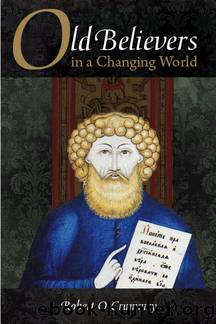Old Believers in a Changing World by Unknown

Author:Unknown
Language: eng
Format: epub
Published: 2012-04-08T00:00:00+00:00
Chapter Eleven
Interpreting the Fate of Old Believer Communities in the Eighteenth and Nineteenth Centuries
Interpreting the history of Old Belief presents many challenges. Apart from the inherent complexity of the movement (if we can use so neat a label), historians must wrestle with the ideological assumptions and loyalties of earlier generations of scholars and publicists, for their writings in large measure still shape our varied understandings of the Old Believersâ aspirations and our explanations of their fate. As we observed in chapter 1, until recently historians of Old Belief have tended to divide into two camps, the ecclesiastical and the populist. Both have their strengths and their limitations in analyzing the structure, history, and fate of Old Believer communities. With their focus on liturgical, theological, and canonical issues, ecclesiastical scholars of the movement paid relatively little attention to Old Believer communities except as centers of opposition to the teachings and practices of the official Orthodox Church.
The populist approach had both strengths and limitations. Since its proponents saw Old Belief as an expression of the latent radicalism of the lower classes of the Russian Empire, they concentrated on its geographical spread and social composition, its organizational structures, and its political impact. These emphases made Old Believer communities a central element in the populistsâ understanding of the movementâs history. At the same time, the populistsâ priorities distorted their treatment of the communitiesâ history and fate for, in addition to undervaluing the theological, liturgical, and canonical issues that preoccupied the Old Believers themselves, they tended to neglect or dismiss the more conservative elements in the movement. In populistsâ writings, priestly Old Believers often appear less authentic than the priestless, and those who reluctantly made their peace with the imperial authorities less admirable than their more radical brothers and sisters. Similarly, the populist system of values tended to give greater moral weight to peasant Old Believers than to the merchants and other townspeople who played leading roles in the movementâs later history. Taken together, these ideological commitments and emotional attachments produced a misleading pattern of historical evolution.
In recent decades, scholars of Old Belief have strived to draw on the strengths of both traditional schools of interpretation and to avoid their extremes. The history of the most important Old Believer communities offers a helpful vantage point from which to do so. Yet this subject has received relatively little attention, particularly in recent years.1 The sole exception is the Vyg community, the most important center of priestless Old Belief from the first years of the eighteenth century until the reign of Catherine II and an important cultural and organizational force until the officials and gendarmes of Nicholas I finally destroyed it in the 1850s.2 In addition, some recent historians of industrial development and urban life in the late eighteenth and nineteenth centuries have discussed the Old Believer centers in Moscow that suddenly became prominent in the reign of Catherine II.3 Otherwise, prerevolutionary Russian publicationsâecclesiastical and populistâstill provide the most useful information on the later history of Old Belief and of the communities that served as its lighthouses.
Download
This site does not store any files on its server. We only index and link to content provided by other sites. Please contact the content providers to delete copyright contents if any and email us, we'll remove relevant links or contents immediately.
The 5 Love Languages: The Secret to Love That Lasts by Gary Chapman(9523)
The Space Between by Michelle L. Teichman(6818)
Assassin’s Fate by Robin Hobb(6063)
Wiseguy by Nicholas Pileggi(5618)
Everything Happens for a Reason by Kate Bowler(4617)
Gerald's Game by Stephen King(4521)
Pillow Thoughts by Courtney Peppernell(4179)
A Simplified Life by Emily Ley(4073)
The Power of Positive Thinking by Norman Vincent Peale(3960)
Resisting Happiness by Matthew Kelly(3270)
Harry Potter and the Prisoner of Azkaban (Book 3) by J. K. Rowling(3256)
Girl, Wash Your Face by Rachel Hollis(3179)
Being Aware of Being Aware by Rupert Spira(3176)
The Code Book by Simon Singh(3031)
More Language of Letting Go: 366 New Daily Meditations by Melody Beattie(2945)
Real Sex by Lauren F. Winner(2939)
Name Book, The: Over 10,000 Names--Their Meanings, Origins, and Spiritual Significance by Astoria Dorothy(2915)
The Secret Power of Speaking God's Word by Joyce Meyer(2874)
The Holy Spirit by Billy Graham(2840)
